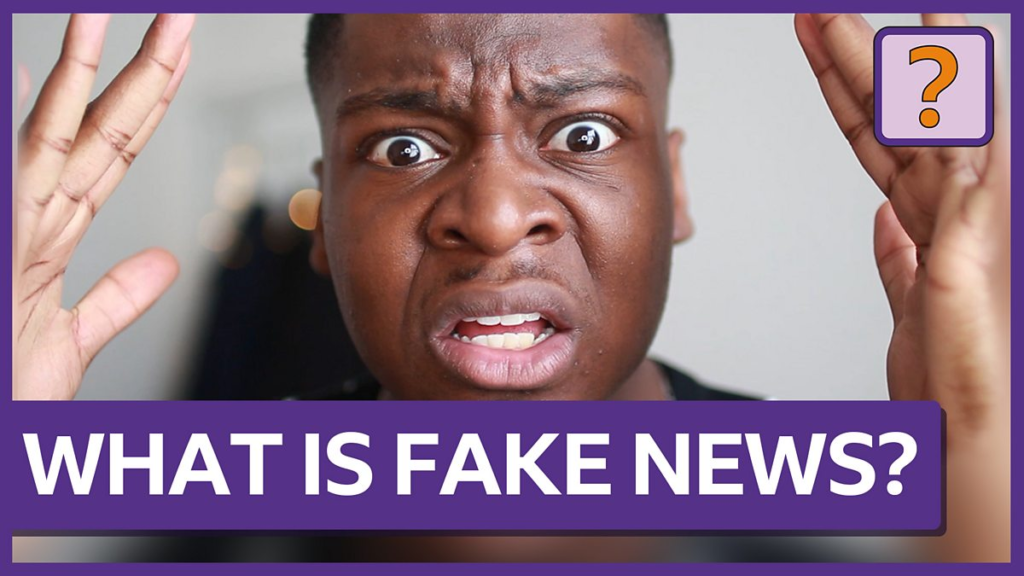Part of Other Side of the Story
Save to My Bitesize
In this episode of For Fake’s Sake, TikTok star Ehiz Ufuah speaks to Marianna Spring from the BBC’s anti-disinformation team about what to look for when deciding if a source is reliable.
This video can not be played
Ehiz: Hello and welcome. I’m Ehiz and today we’re talking all things fake news, in the latest episode of For Fake’s Sake. And remember, fake news can be anything from a deceptive video in your feed, to a popular blogger just making stuff up. Today, we’re going to look at how you can tell a good source from a bad one, and believe me, it’s an important skill because once, I ate raw eggs because I read that it would make me fit but actually, I got sick. Not fun. So, I’ve invited BBC journalist, Marianna Spring, onto the show today. She’s an expert in misinformation – in other words, information which isn’t true.
Ehiz: Hello Marianna, thank you so much for joining us today. So you are a Disinformation Reporter, is that correct?
Marianna: Yes, it is. So I spend a lot of my time looking into misleading and false claims being shared on social media. I investigate them and I debunk them.
Ehiz: So, can you tell us how we can find a reliable source?
Marianna: Yes, it’s really important to think about where information has come from. If information comes from an expert or a journalist who knows a lot about that topic, it’s likely to be more reliable than information coming from a vlogger or an influencer who knows less about it. In general, it’s really good to look at multiple sources, to see whether something is being backed up by other people or by other trusted places.
Ehiz: Okay, cool. So can it be any sources online so I can check a few?
Marianna: No, not really. There are some sources that are more reliable than others. For instance, government websites or guidelines are frequently updated and journalists are held accountable for what they write and say, which is checked by an editor before it goes live, whereas someone posting on their Instagram page isn’t subject to those same checks and accountability. For that reason, if you wanted information about coronavirus, for example, it would be much better to go to the NHS website than to a random Instagram influencer’s page.
Ehiz: That’s a really good point. What if you don’t know who made the content?
Marianna: If you don’t know who made the content, it’s really important to look at the content itself. So ask yourself whether it sounds realistic or believable. Does the person who shared it back up what they’re saying with facts, links or other evidence? And also, think about how it makes you feel. It’s often really emotive content that can actually be misleading, whereas accurate information tends to be quite boring.
Ehiz: Thank you so much for that information, it was very useful.
Marianna: My pleasure.
Ehiz: That was definitely helpful. I never realised how important it is to look at who made the piece. So, check that and check multiple sources, paying extra attention to the most trusted ones. And be sure to watch out for arguments that don’t really add up, or that don’t include reliable evidence. Alright, that’s it for today’s episode. I hope you learned as much as I did.
1. Check who made it
Some sources are more reliable than others – make sure you’re getting news from journalists and official news sites, rather than just social media. Journalists are held to account for what they report and any story in a news outlet will have gone through checks and an editor.
So have a look at what they’ve previously written and if their news seems accurate and unbiased – that they just report on the facts, rather than giving an opinion.
2. Check multiple sources
If the same information can be found on other websites or accounts, it might suggest that what the source is saying has been verified by other people too.
Checking multiple sources is a great way to make sure that a person can be trusted, as it shows that other reporters have come to the same conclusion about a news story and that it’s more likely to be true.
3. Check for reliable evidence
Have a look to see if the writer, journalist or even social media source is backing up their story with trustworthy evidence. It’s always a good sign if you can find where the news has come from and clearly see the facts behind the piece.
It’s also good to ask yourself if what the source is saying sounds believable. If it appears a bit out of this world or too good to be true, then the chances are that it might well be.
Think like a journalist: How to check a story
BBC journalist Tina Daheley explains how she checks the facts when reporting on the latest news.
How to be impartial and separate facts from opinions – BBC Young Reporter
Take a look inside the newsroom and see what it takes to be a trusted journalist and a reliable news source.
The seven types of people who start and spread viral misinformation
Conspiracy theories and speculation about coronavirus have flooded social media. But who starts these rumours? And who spreads them?
Fact or Fake?
Find out how to spot and stop fake news with BBC Bitesize.
Copyright © 2025 BBC. The BBC is not responsible for the content of external sites. Read about our approach to external linking.
What are reliable sources? – BBC
